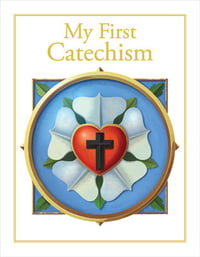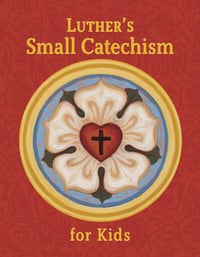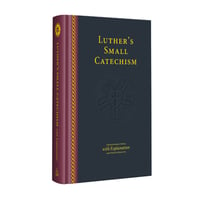More than just a text to memorize, the Small Catechism is a faithful tool for forming children and families in the faith. Hear more about how Christa Petzold, uses the catechism in her household.
Using the Catechism to Disciple Our Children
Last fall, I wrote a blog post about the benefits of memorizing the catechism with our kids. Now, deep into the mid-winter slump portion of the school year, we are still working through our catechism along with our other homeschool subjects, but the memorization part is not perfect. My kids retain more each time we work through it, but I don’t want you to picture me sitting in a tidy, orderly room, my children lined up neatly as I quiz them one at a time and they flawlessly recite entire explanations to the articles of the Apostles’ Creed. I promise, that is not what is happening in my home. Our devotional time is often chaotic. I sometimes wonder if they’re even paying attention. But then my husband and I will overhear one of our children “preaching” for five to ten minutes to the others, explaining the intricacies of Jesus’ death, resurrection, ascension, and coming return, and we’ll look at each other and raise our eyebrows, remembering this same child’s reluctance to go to church this past week. The Holy Spirit works through the Word!
Our children absorb much more than what we teach them explicitly. While teaching the catechism may seem like a daunting task, much of it is caught through the life of the church and through the conversations about faith that organically happen in our homes.
The Order of the Six Chief Parts
When Martin Luther wrote the Small Catechism (expressly for the purpose of teaching the faith in the home), he placed the Six Chief Parts in a specific order to teach us about our relationship with God. The Ten Commandments appear first, containing God’s unchanging and eternal Law and will for His people. In his explanation to the close of the commandments, Luther says, “God threatens to punish all who break these commandments. Therefore, we should fear His wrath and not do anything against them. But He promises grace and every blessing to all who keep these commandments. Therefore, we should also love and trust in Him and gladly do what He commands.” What is not stated here, yet is glaringly obvious, is that we cannot keep these commandments. As sinners, we know that we will fail.
This leads us to the Apostles’ Creed, which tells about God’s plan of salvation through Jesus Christ. After encountering God’s Law in the commandments, we turn to Jesus and His cross for help. The Creed is followed by the Lord’s Prayer, which flows naturally out of the restored relationship we have with our heavenly Father because of Christ. Because of the nature of who God is and His deeds, as professed in the Creed, we can have a relationship with our Father and approach Him in prayer. The following three parts, Baptism, Confession, and the Lord’s Supper, are the ways in which Jesus meets us in our everyday lives as Christians. God is at work through each of these Means of Grace, forgiving sin and giving and strengthening faith. Because of this sanctifying work of the Holy Spirit in our lives, we can start the cycle all over again with the Ten Commandments, this time hearing them as God’s good design for us as we live as His children. The six parts are cyclical—when we fail to keep the Law, we are again reminded of Christ’s work, His invitation to pray, and the way in which Jesus meets with us to forgive our sins.
Faith in the Family, Active in Church
What a blessing when children are raised immersed in this faith cycle from infancy! For little ones raised in the church, their Baptism is their most meaningful encounter with God’s forgiveness and grace, but this is an event that they do not often participate in actively or remember. We teach our children about Baptism from the beginning, repeating God’s promises to them from infancy on so that there is no time in their lives when they do not know that they received the Holy Spirit and became a child of God in their Baptism.
In our family, we have never needed to formally teach the Lord’s Prayer, as they hear it each week in church and we say it together before bed each night as part of our evening devotions. For each of my kids, I look forward to that special moment when we are in church and recognition dawns on their little toddler face for the first time as they hear the familiar words and excitedly fold their hands to participate.
The Apostles’ Creed is learned in much the same way. Through regular attendance at church, and perhaps a few weeks of at-home practice, kids can absorb it at a very young age. Once my children know both the Lord’s Prayer and the Apostles’ Creed, I try to point out those portions of the church service so they can participate. I teach them about the Lord’s Supper by whispering explanations to them during the service: that Jesus is truly present in the bread and the wine, and that forgiveness of sins and strengthening of faith are offered to us in the Sacrament. When we return to our pew after Communion, I try to gather them around me and pray. Something like, “Dear Jesus, thank You for meeting with us here today. Thank You for forgiving our sins and for promising to always be with us. Help us to believe in You, and strengthen us to be able to obey Your Word and show one another Your love and kindness this week.” This is a simple way to communicate to children the essence of how Jesus works through the Sacrament before they receive Communion themselves. Some of my kids appear indifferent about this ritual for now, but others already seem to look forward to it.
Embrace the Catechism and Nourish Your Kids
By the time we start memorizing the Ten Commandments and their explanations, our children already know the Lord’s Prayer, the Apostles’ Creed, the blessings received in their Baptism, and a bit of what Confession and Communion are about. Understanding the catechism’s progression and the way the Six Chief Parts work together to summarize and teach God’s Law and Gospel is helpful as we seek to create the environment of immersion in God’s Word referenced in Deuteronomy 6:And these words that I command you today shall be on your heart. You shall teach them diligently to your children, and shall talk of them when you sit in your house, and when you walk by the way, and when you lie down, and when you rise. (Deuteronomy 6:6–7)
Teach your family the Six Chief Parts of the Catechism with these resources for every age and stage.
 My First Catechism
My First Catechism
Recommended for: Preschool - Grade 1
Features:
- Sections on each of the 6 chief parts
- Realistic illustrations with life application
- Durable hardcover
 Luther's Small Catechism for Kids
Luther's Small Catechism for Kids
Recommended for: Grades 2-5
Features:
- Sections on each of the 6 chief parts
- Simplified questions and answers
- Bible story connections
- Family devotional activities
 Luther's Small Catechism with Explanation - 2017 Edition
Luther's Small Catechism with Explanation - 2017 Edition
Recommended for: Grades 6+
Features:
- 3 editions (hardback, spiral, and visual)
- Full catechism with explanation
- Central Thought with reflection questions for each section
- Psalms, hymns, and prayers


























